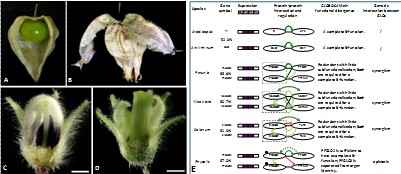Physalis develops the ‘Chinese lantern’ trait, also known as inflated calyx syndrome (ICS) that is a morphological novelty. Interacting and regulatory networks associated with MADS-box gene MPF2 form the major underlying genetic basis for the development of ICS that links with male fertility. Very recently, Dr. He’s group identified the double-layered-lantern 1 (doll1) mutant in Physalis floridana, a recessive and monofactorial mutation; its corolla and androecium were transformed into the calyx and gynoecium, respectively. Moreover, the female functionality was severely impaired. Two GLOBOSA-like (GLO) MADS-box paralogous genes PFGLO1 and PFGLO2 were found in P. floridana, while the mutated phenotype was co-segregated with a large deletion harboring PFGLO1 and was complemented by the PFGLO1 genomic locus in transgenic plants, and severe PFGLO1 knockdowns phenocopied doll1. Thus, DOLL1 encodes the PFGLO1 protein and plays a primary role in determining corolla and androecium identity. However, specific PFGLO2 silencing showed no homeotic variation but rather affected pollen maturation. The two genes featured identical floral expression domains but the encoding proteins shared 67% identity in sequences. PFGLO1 was localized in the nucleus when expressed in combination with PFDEF, whereas PFGLO2 was imported to the nucleus on its own. The two proteins were further found to have evolved different interacting partners and regulatory patterns, supporting the hypothesis that PFGLO2 is functionally separated from organ identity. Such a divergent pattern of duplicated GLO genes is unusual within the Solanaceae. Moreover, the phenotypes of the PFGLO1PFGLO2 double silencing mutants suggested that PFGLO2, through genetically interacting with PFGLO1, also exerts a role in the control of organ number and tip development of the second floral whorl. Our results, therefore, shed new light on the functional evolution of the duplicated GLO genes in angiosperms and on the evolution and development of the “Chinese lantern” in Physalis.
This work has been published in Plant Physiology Preview (Zhang et al. 2014 doi:10.1104/pp.113.233072). This work was supported by grants (31070203 and 30870175) from the National Natural Science Foundation of China.

Figure 1 Deciphering the Physalis double-layered-lantern 1 mutant (doll1) provides insights into functional divergence of the GLOBOSA duplicates within the Solanaceae.
(A) A “Chinese lantern” trait of the wild-type Physalis floridana; (B) A double-layered-lantern trait in doll1; (C) A wild-type flower bud; (D) A doll1 flower bud; (E) Divergent trajectory of the GLOBOSA duplicates within the Solanaceae.
Physalis develops the ‘Chinese lantern’ trait, also known as inflated calyx syndrome (ICS) that is a morphological novelty. Interacting and regulatory networks associated with MADS-box gene MPF2 form the major underlying genetic basis for the development of ICS that links with male fertility. Very recently, Dr. He’s group identified the double-layered-lantern 1 (doll1) mutant in Physalis floridana, a recessive and monofactorial mutation; its corolla and androecium were transformed into the calyx and gynoecium, respectively. Moreover, the female functionality was severely impaired. Two GLOBOSA-like (GLO) MADS-box paralogous genes PFGLO1 and PFGLO2 were found in P. floridana, while the mutated phenotype was co-segregated with a large deletion harboring PFGLO1 and was complemented by the PFGLO1 genomic locus in transgenic plants, and severe PFGLO1 knockdowns phenocopied doll1. Thus, DOLL1 encodes the PFGLO1 protein and plays a primary role in determining corolla and androecium identity. However, specific PFGLO2 silencing showed no homeotic variation but rather affected pollen maturation. The two genes featured identical floral expression domains but the encoding proteins shared 67% identity in sequences. PFGLO1 was localized in the nucleus when expressed in combination with PFDEF, whereas PFGLO2 was imported to the nucleus on its own. The two proteins were further found to have evolved different interacting partners and regulatory patterns, supporting the hypothesis that PFGLO2 is functionally separated from organ identity. Such a divergent pattern of duplicated GLO genes is unusual within the Solanaceae. Moreover, the phenotypes of the PFGLO1PFGLO2 double silencing mutants suggested that PFGLO2, through genetically interacting with PFGLO1, also exerts a role in the control of organ number and tip development of the second floral whorl. Our results, therefore, shed new light on the functional evolution of the duplicated GLO genes in angiosperms and on the evolution and development of the “Chinese lantern” in Physalis.
This work has been published in Plant Physiology Preview (Zhang et al. 2014 doi:10.1104/pp.113.233072). This work was supported by grants (31070203 and 30870175) from the National Natural Science Foundation of China.

Figure 1 Deciphering the Physalis double-layered-lantern 1 mutant (doll1) provides insights into functional divergence of the GLOBOSA duplicates within the Solanaceae.
(A) A “Chinese lantern” trait of the wild-type Physalis floridana; (B) A double-layered-lantern trait in doll1; (C) A wild-type flower bud; (D) A doll1 flower bud; (E) Divergent trajectory of the GLOBOSA duplicates within the Solanaceae.
